Plextor M9Pe SSD Review
Why you can trust Tom's Hardware
1TB Class Performance Testing
Comparison Products
Plextor has released three NVMe families that span thirty-three SKUs when you factor in all capacities and form factors. We'll focus on the M9Pe in the HHHL form factor (Y) and the bare M.2 2280 (GN). We also include the HHHL versions of the M8Pe with MLC NAND and the M8Se model with TLC.
We rounded up Intel's 750 and 600p NVMe SSDs for the test pool. We also selected Samsung's 960 series and Toshiba's OEM SSD that also uses 64-layer BiCS Flash. These BiCS-powered SSDs allow us to compare Toshiba's NVMe controller to the Marvell 88SS1093 in the new Plextor M9Pe.
Sequential Read Performance
To read about our storage tests in-depth, please check out How We Test HDDs And SSDs. We cover four-corner testing on page six of our How We Test guide.


The Plextor M9Pe SSDs deliver solid mainstream sequential read performance. Plextor's latest is faster during the 128K read workload than the M8Se, but the MLC-based M8Pe is still slightly better at a queue depth (QD) of 2. The M9Pe trails the Samsung 960 EVO.
Sequential Write Performance


The new Plextor 1TB models are faster than the 960 EVO in our new write burst test. The M9Pe is also much faster than the two previous Plextor NVMe drives, but it can only cache a limited amount of data before dropping to native TLC speeds.
The M9Pe has a very small pSLC (pseudo-SLC) buffer compared to many of the newer products we've tested. For instance, Silicon Motion's SM2263XT 512GB SSD has a 70GB cache. The M9Pe's buffer appears to be 10GB or less.
Once the buffer is saturated the M9Pe drops to ~750 MB/s of native TLC sequential write throughput. That much throughput is fast enough to keep you happy, but it is far from the 2,100 MB/s listed in the specifications.
Get Tom's Hardware's best news and in-depth reviews, straight to your inbox.
Random Read Performance
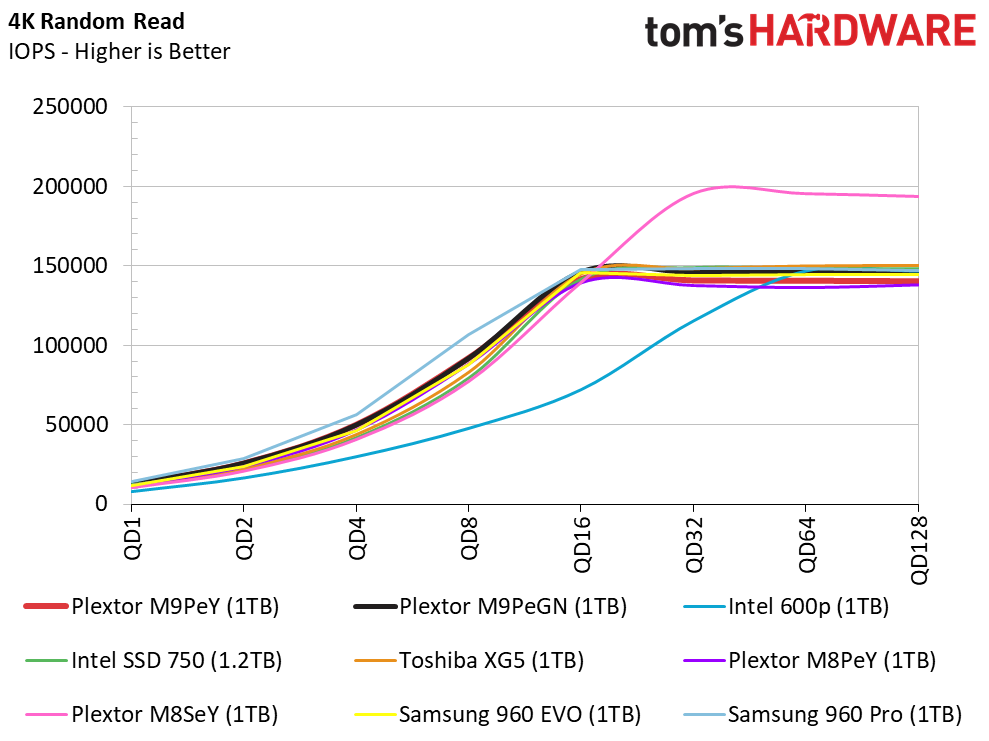
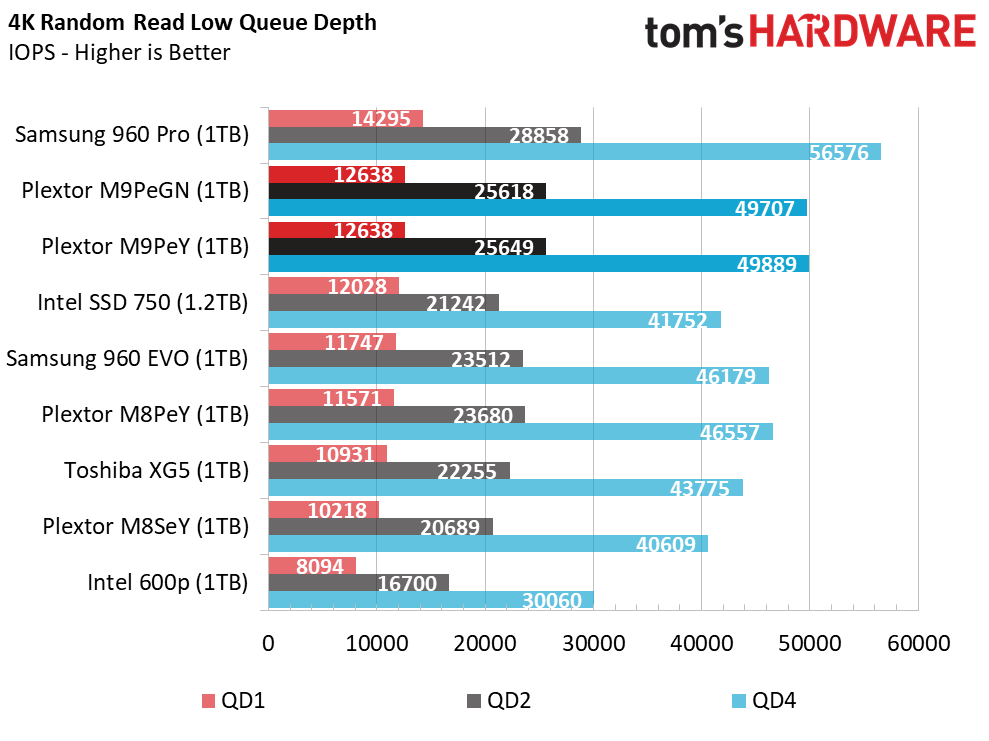

We've finally reached a point when most NVMe SSDs can read random data faster than 10,000 IOPS at QD1. The M9Pe 1TB SSDs approach 13,000 IOPS, but the 960 Pro tops 14,000 IOPS.
Random Write Performance


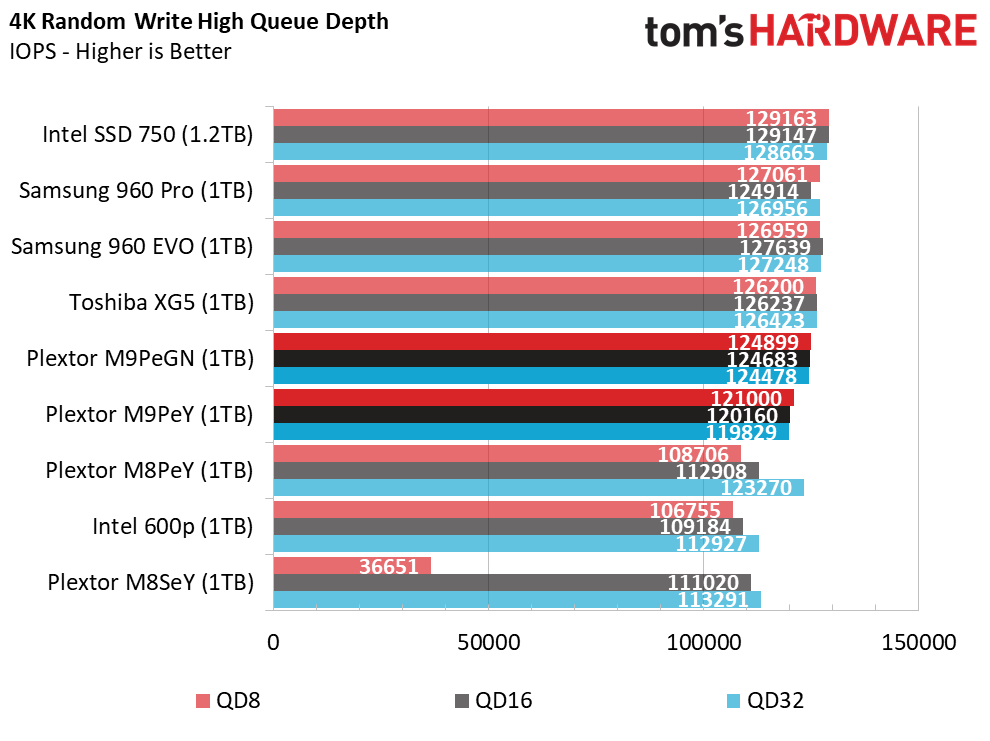
Toshiba's new BiCS Flash is a big improvement over planar 15nm TLC. The random write test reveals improved consistency compared to the M8Se. The M8Se's smaller SLC buffer and lower sustained write speed manifest as waves in the line chart. We didn't expect this result in our new burst test, but it shows how much better 64-layer NAND technology is than older planar TLC.
70% Mixed Sequential Workload
We describe our mixed workload testing in detail here and describe our steady state tests here.


Toshiba's 64-layer TLC NAND is fascinating. The technology enables two data writes on the same programming pass. That technique enables the highest sequential mixed workload results we've measured with a NAND-based SSD. The new Plextor SSDs don't achieve the same results as Toshiba's XG5 with the same flash, but they do blow past Samsung's 960 Pro.
70% Mixed Random Workload

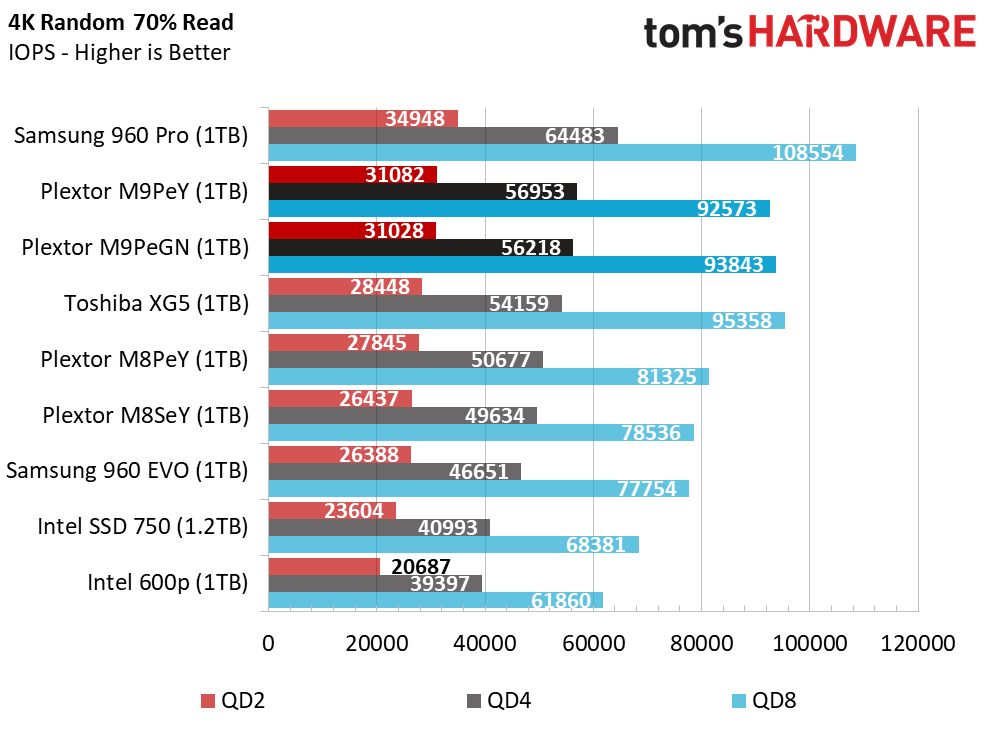
The M9Pe's mixed random performance is also very impressive. Solid performance in mixed workloads leads to a responsive user experience that you will feel when you move between applications.
Sequential Steady-State


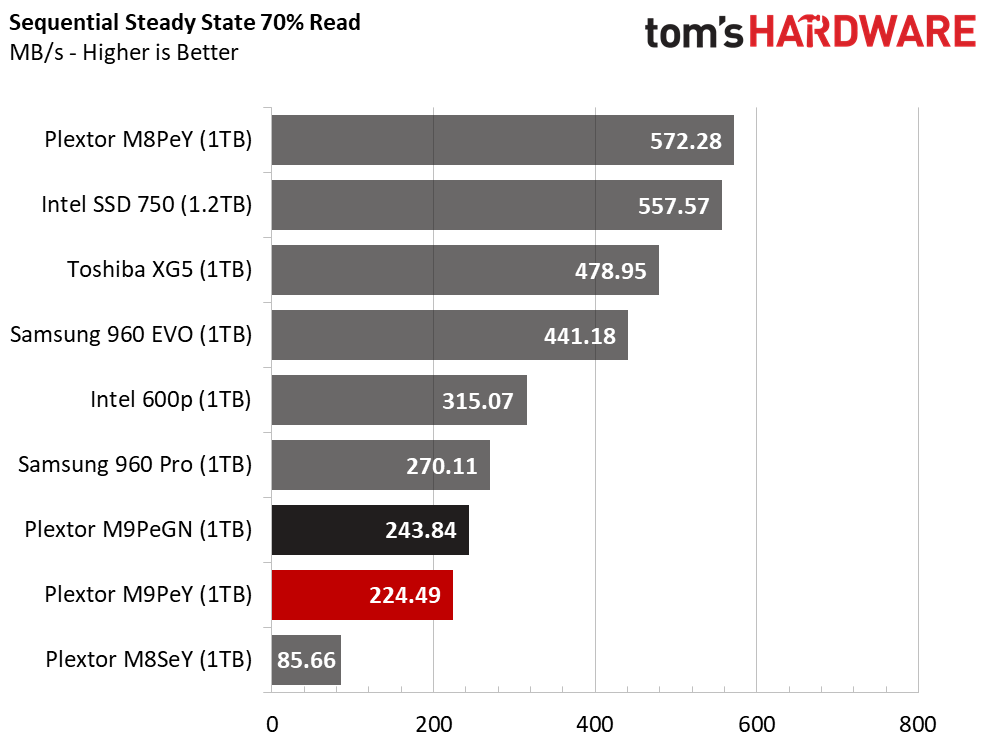
The Toshiba XG5 with TLC NAND and the 960 EVO with 3D TLC V-NAND improve during the write-intensive portion of the test (right side of the chart). All of the other TLC-based drives follow a declining slope into the abyss of sequential steady-state. This trend tells us the new Plextor M9Pe is consumer-focused and not a serious option for the heavy write environment of a workstation.
Random Steady-State


The new drives are consistent and provide unwavering performance during the random steady-state test. The MP9e's average performance is also impressive at more than 20,000 IOPS. The high level of consistency would provide great performance in a consumer-class RAID 0 array.
PCMark 8 Real-World Software Performance
For details on our real-world software performance testing, please click here.
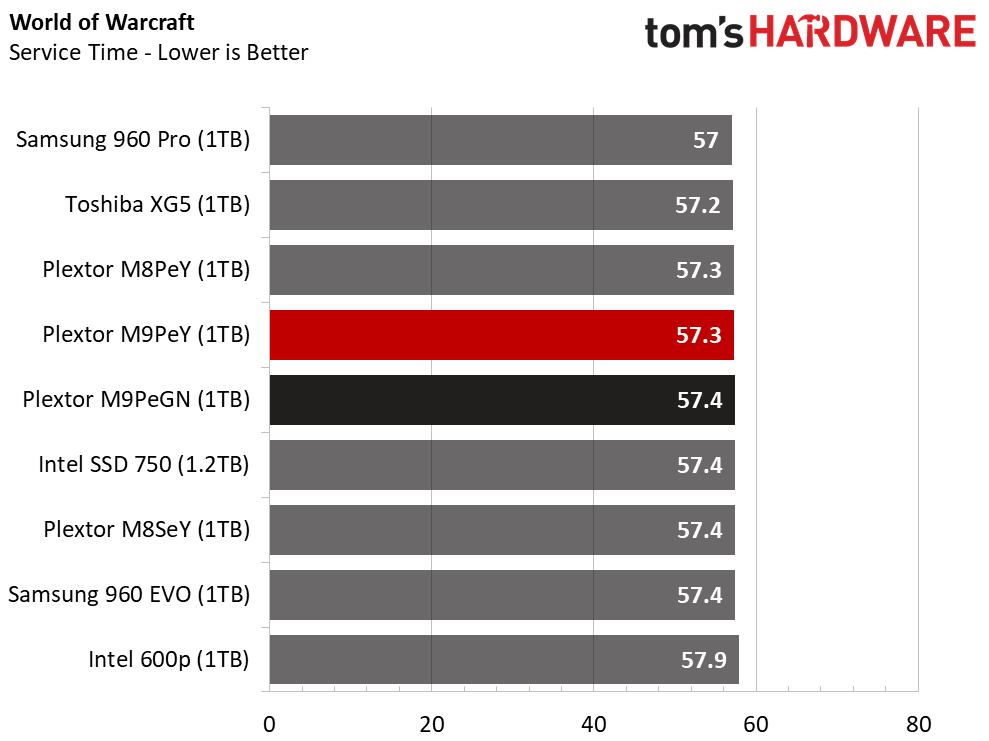


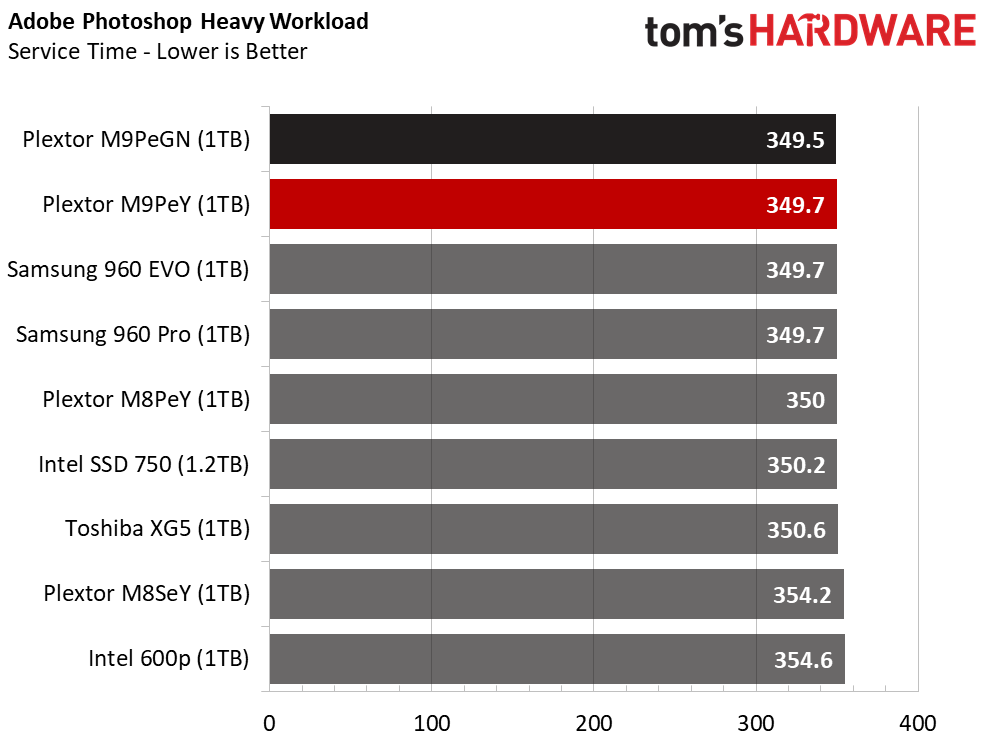




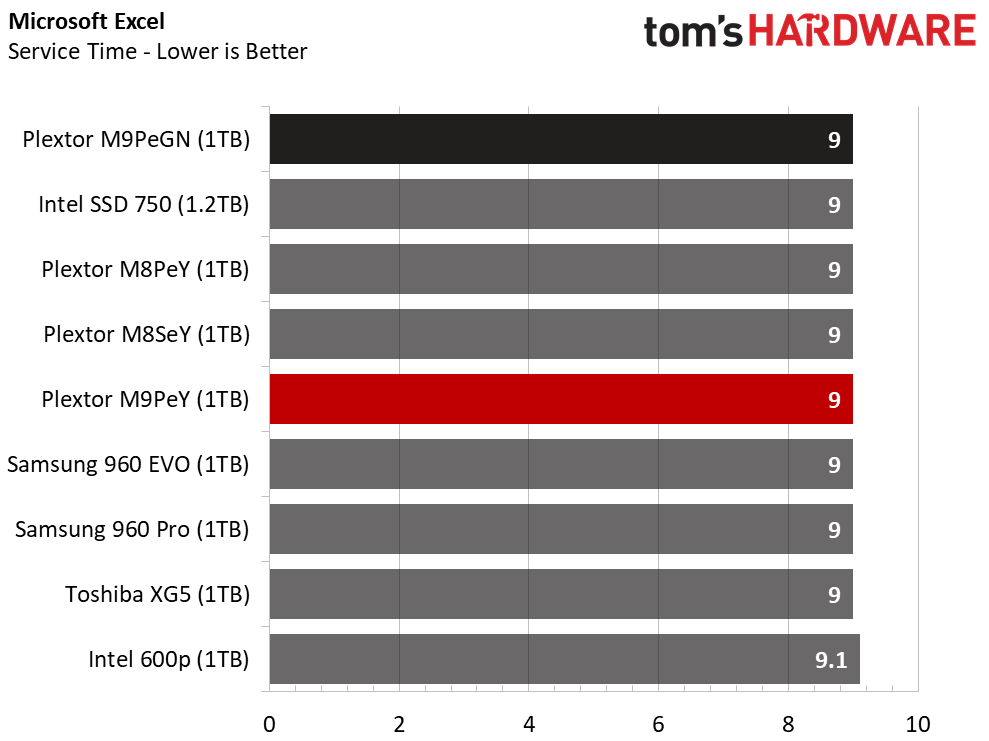

The older Marvell 88SS1093 eight-channel controller performs well with the new 64-layer flash. The M9Pe SSDs complete the Photoshop Heavy tasks, which are the most demanding of the suite, much faster than the other drives. The drives fall back in the hierarchy during the lighter tests.
Application Storage Bandwidth
Overall performance is good, but you can still purchase affordable MLC-based SSDs like the M8Pe. Resellers will cut MLC SSD pricing to move existing inventory as the new TLC SSDs come to market.
PCMark 8 Advanced Workload Performance
To learn how we test advanced workload performance, please click here.



We don't see a large performance delta between heavy and light workloads with the M9Pe. The M8Pe behaved the same as the M9Pe when we tested it in mid-2016. The Marvell controller only has three cores that are easy to overload during heavy use. That causes throttling, which reduces the controller's ability to clean the flash cells and run other background activity.
Total Service Time



NVMe SSDs are beginning to stratify into different performance tiers. The M9Pe falls between the competing premium and entry-level models.
Disk Busy Time
The disk busy time test measures how long the drives actually work to complete the workload. The drive drops down into a lower power state when it finishes the tasks, which usually results in longer notebook battery life and less power consumption.
BAPCo SYSmark 2014 SE Responsiveness Test


The responsiveness test quantifies the user experience by measuring how long it takes to begin and finish tasks inside Windows. It includes applications most of us use every day, like Microsoft Word. The new M9Pe without a heatsink is on the heels of the two Samsung 960 products. The drive also outperforms the aging M8Pe.
The 28nm Marvell controller is the oldest in the group, and that shows in the power consumption results.
BAPCo MobileMark 2012.5 Notebook Battery Life

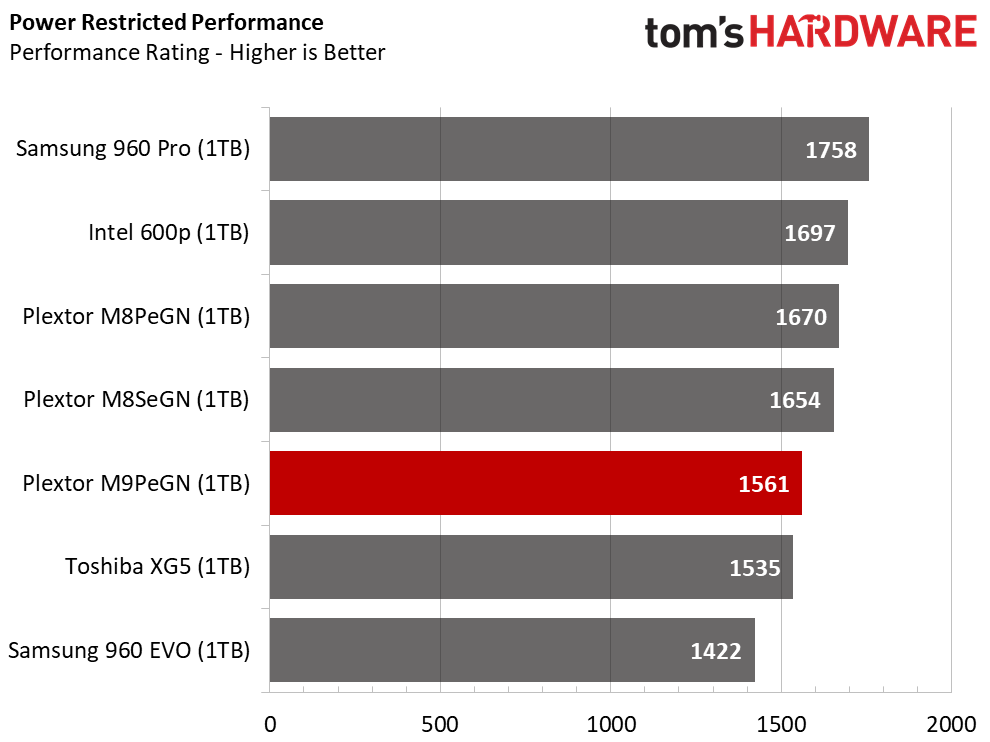
The extra power consumption also shows up in our notebook battery life test. Here we use a Lenovo Y700-17 with specialized software that records performance with the system buses in a low power state. The software runs common office applications until it depletes the battery.
We only use the GN models for the notebook tests because the add-in cards are not compatible with our laptop. The M8Pe provides almost an hour more battery life than the newer M9Pe model.
MORE: Best SSDs
MORE: How We Test HDDs And SSDs
MORE: All SSD Content
Current page: 1TB Class Performance Testing
Prev Page Specifications & Pricing Next Page 512GB Class Performance Testing
Chris Ramseyer was a senior contributing editor for Tom's Hardware. He tested and reviewed consumer storage.
-
WyomingKnott "We'll see more new products introduced than ever before with higher capacities, newer controllers, and lower price points."Reply
And, sadly, falling performance as drives are no longer made with single-bit cell flash. I'm positive that cheaper will drive out faster in this area; I'm curious as to whether a high-end segment will persist or if we have actually reached peak performance for flash SSDs and it will be all downhill from here. Will last year's best SSDs be traded like rare antiques someday? -
richardvday Sadly the editing in these articles is horrible anymore. This article is rife with bad punctuation and missing words so the sentences make no sense without them.Reply
Many articles come out like this anymore here its really getting bad. -
Sakkura Reply20549352 said:"We'll see more new products introduced than ever before with higher capacities, newer controllers, and lower price points."
And, sadly, falling performance as drives are no longer made with single-bit cell flash. I'm positive that cheaper will drive out faster in this area; I'm curious as to whether a high-end segment will persist or if we have actually reached peak performance for flash SSDs and it will be all downhill from here. Will last year's best SSDs be traded like rare antiques someday?
3DXPoint will cover the extreme performance segment just fine. What people want from flash SSDs is more GB per dollar. And it looks like 2018 will finally start to get us back on track there.
20549381 said:Wondering where 960 evo stands in those graphs...
It's included in the 1TB graphs. Probably would turn up in about the same place in the ½TB graphs. -
cerealkeller The box is deceiving, it makes you think the PCI-E version has an integrated fan. Which it probably should if thermal throttling is an issue.Reply





